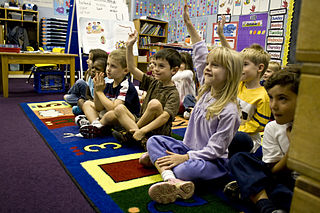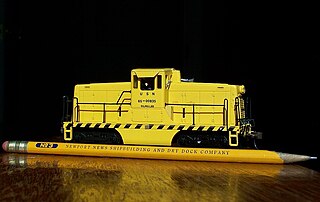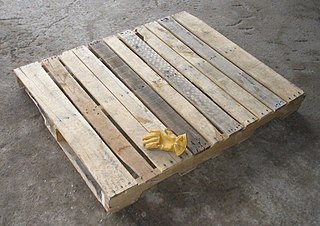
Elizabeth Palmer Peabody was an American educator who opened the first English-language kindergarten in the United States. Long before most educators, Peabody embraced the premise that children's play has intrinsic developmental and educational value.

Kindergarten is a preschool educational approach based on playing, singing, practical activities such as drawing, and social interaction as part of the transition from home to school. Such institutions were originally made in the late 18th century in Germany, Bavaria and Alsace to serve children whose parents both worked outside home. The term was coined by German pedagogue Friedrich Fröbel, whose approach globally influenced early-years education. Today, the term is used in many countries to describe a variety of educational institutions and learning spaces for children ranging from 2 to 6 years of age, based on a variety of teaching methods.

A scale model is a physical model which is geometrically similar to an object. Scale models are generally smaller than large prototypes such as vehicles, buildings, or people; but may be larger than small prototypes such as anatomical structures or subatomic particles. Models built to the same scale as the prototype are called mockups.

Child care, otherwise known as day care, is the care and supervision of a child or multiple children at a time, whose ages range from two weeks of age to 18 years. Although most parents spend a significant amount of time caring for their child(ren), child care typically refers to the care provided by caregivers that are not the child's parents. Child care is a broad topic that covers a wide spectrum of professionals, institutions, contexts, activities, and social and cultural conventions. Early child care is an equally important and often overlooked component of child's developments.
Alternative education encompasses many pedagogical approaches differing from mainstream pedagogy. Such alternative learning environments may be found within state, charter, and independent schools as well as home-based learning environments. Many educational alternatives emphasize small class sizes, close relationships between students and teachers and a sense of community.

A preschool, also known as nursery school, pre-primary school, or play school or creche, is an educational establishment or learning space offering early childhood education to children before they begin compulsory education at primary school. It may be publicly or privately operated, and may be subsidized from public funds.

HO or H0 is a rail transport modelling scale using a 1:87 scale. It is the most popular scale of model railway in the world. The rails are spaced 16.5 millimetres (0.650 in) apart for modelling 1,435 mm standard gauge tracks and trains in HO.

Friedrich Wilhelm August Fröbel or Froebel was a German pedagogue, a student of Johann Heinrich Pestalozzi, who laid the foundation for modern education based on the recognition that children have unique needs and capabilities. He created the concept of the kindergarten and coined the word, which soon entered the English language as well. He also developed the educational toys known as Froebel gifts.

A pallet is a flat transport structure, which supports goods in a stable fashion while being lifted by a forklift, a pallet jack, a front loader, a jacking device, or an erect crane. A pallet is the structural foundation of a unit load, which allows handling and storage efficiencies. Goods in shipping containers are often placed on a pallet secured with strapping, stretch wrap or shrink wrap and shipped. Since its invention in the twentieth century, its use has dramatically supplanted older forms of crating like the wooden box and the wooden barrel, as it works well with modern packaging like corrugated boxes and intermodal containers commonly used for bulk shipping. In addition, pallet collars can be used to support and protect items shipped and stored on pallets.

K'Nex is a construction toy system founded by Joel Glickman. It was first introduced in America in 1992. K'Nex is designed and produced by K'Nex Industries Inc. of Hatfield, Pennsylvania. K'Nex was purchased by Florida-based company Basic Fun! in 2018.

The Froebel gifts are educational play materials for young children, originally designed by Friedrich Fröbel for the first kindergarten at Bad Blankenburg. Playing with Froebel gifts, singing, dancing, and growing plants were each important aspects of this child-centered approach to education. The series was later extended from the original six to at least ten sets of gifts.

A construction set is a set of standardized pieces that allow for the construction of a variety of different models. The pieces avoid the lead-time of manufacturing custom pieces, and of requiring special training or design time to construct complex systems. This makes them suitable for temporary structures, or for use as children's toys. One very popular brand is Lego.

Susan Elizabeth Blow was an American educator who opened the first successful public kindergarten in the United States. She was known as the "Mother of the Kindergarten."

Toy blocks are wooden, plastic, or foam pieces of various shapes and colors that are used as construction toys. Sometimes, toy blocks depict letters of the alphabet.
Student–teacher ratio or student–faculty ratio is the number of students who attend a school or university divided by the number of teachers in the institution. For example, a student–teacher ratio of 10:1 indicates that there are 10 students for every one teacher. The term can also be reversed to create a teacher–student ratio.

A Howe truss is a truss bridge consisting of chords, verticals, and diagonals whose vertical members are in tension and whose diagonal members are in compression. The Howe truss was invented by William Howe in 1840, and was widely used as a bridge in the mid to late 1800s.

Educational toys are objects of play, generally designed for children, which are expected to stimulate learning. They are often intended to meet an educational purpose such as helping a child develop a particular skill or teaching a child about a particular subject. They often simplify, miniaturize, or even model activities and objects used by adults.

The City and Country School is a progressive independent pre-school and elementary school for children aged 2–14 that is located in the Greenwich Village section of New York City.

Caroline Pratt was an American social thinker and progressive educational reformer whose ideas were influential in educational reform, policy, and practice.
Helene Hibben (1882–1969) was an American artist from Indianapolis. Hibben was a sculptor and is a confirmed participant in the Indianapolis City Hospital Project. She created a large bronze statue for the creation of the Burdsal Units. It can still be seen on the campus of Sidney and Lois Eskenazi Hospital. She spent a large portion of her life in childcare, caring for children during World War II and teaching at her own school.

















